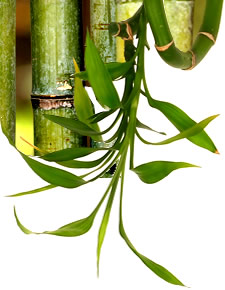

Bamboo Cultural Aspects |
Bamboo's long life makes it a Chinese symbol of long life, while in India it is a symbol of friendship. Its rare blossoming has led to the flowers' being regarded as a sign of impending famine. Several Asian cultures, including that of the Andaman Islands, believe that humanity emerged from a bamboo stem. Malaysian legends include the story of a man who dreams of a beautiful woman while sleeping under a bamboo plant; he wakes up and breaks the bamboo stem, discovering the woman inside. In the Philippines, bamboo crosses are used as a good luck charm by farmers. In Japan, a bamboo forest sometimes surrounds a Shinto shrine as part of a sacred barrier against evils. Also, bamboo is considered second in the rank in the order of "Matsu (pine wood), Take (bamboo), Ume (sometimes translated as apricot or plum)" and this order is used when ordering a sushi course or getting a room in a traditional Ryokan inn. Hawaiian bamboo ('ohe) is a kinolau or body form of the Polynesian creator god Kane. In Chinese culture, the bamboo (竹), along with mei (梅, the same tree as Japanese ume), orchids (蘭), and chrysanthemum (菊) are all held in high esteem and are collectively referred as the "the four of great nobility" (四君子). Each plant represents a particular aspect of a noble person in Confucian ideology. The four plants are commonly mentioned together as "mei2 lan2 zhu2 ju2" (梅蘭竹菊). |
© Copyright yayixm.com All rights reserved. Unauthorized duplication in part or whole strictly prohibited by international copyright law. |
|
|